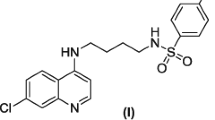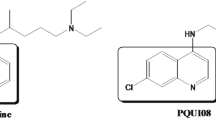Abstract
Methotrexate resistance induced in culturedPlasmodium falciparum depends on an altered dihydrofolate reductase with decreased affinity for methotrexate as well as for pyrimethamine. In contrast, pyrimethamine-resistant field isolates ofP. falciparum lack cross-resistance to methotrexate and 2,4-diamino-5-(substituted benzyl) pyrimidines. The structure of the latter class was optimized by the use of trimethoprim as a lead and the substitution of methoxy groups at the benzyl ring by 3-(4′-aminophenyl-4-sulfonylphenylamino)propoxy or by (4′-aminophenyl-4-sulfonylphenyl)methoxy, which resulted in antimalarials of high potency. The efficiency of these newly designed 2,4-diamino-5-(substituted benzyl) pyrimidines was confirmed by their strong inhibitory effect on plasmodial dihydrofolate reductase as well as by in vitro screening against drug-sensitive and-resistant strains ofP. falciparum.
Similar content being viewed by others
References
Bitonti AJ, Sjoerdsma A, McCann PP, Kyle DE, Oduola AMJ, Rossan RN, Milhous WK, Davidson DE (1988) Reversal of chloroquine resistance in malaria parasitePlasmodium falciparum by desipramine. Science 242:1301–1303
Chen GX, Mueller C, Wendlinger M, Zolg JW (1987) Kinetic and molecular properties of the dihydrofolate reductase from pyrimethamine-sensitive and pyrimethamine-resistant clones of the human malaria parasitePlasmodium falciparum. Mol Pharmacol 31:430–437
Christophers SR, Fulton JD (1939) Experiments with isolated malaria parasites (P. knowlesi) free from red cells. Ann Trop Med Parasitol 33:161–170
Coderre JA, Beverley SM, Schinke RT, Santi DV (1983) Overproduction of a bifunctional thymidylate synthase dihydrofolate reductase and DNA amplification in methotrexate-resistantLeishmania tropica. Proc Natl Acad Sci USA 80:2132–2136
Cowman AF, Morry MJ, Biggs BA, Cross GAM, Foote SJ (1988) Amino acid changes linked to pyrimethamine resistance in the dihydrofolate reductase-thymidylate synthase gene ofPlasmodium falciparum. Proc Natl Acad Sci USA 85:9109–9113
Dewes H, Ostergaard HL, Simpson L (1986) Impaired drug uptake in methotrexate-resistantCrithidia faciculata without changes in dihydrofolate reductase activity or gene amplification. Mol Biochem Parasitol 19:149–161
Dieckmann A, Jung A (1986) The mechanism of pyrimethamine resistance inPlasmodium falciparum. Parasitology 93:275–278
Duffy TH, Beckmann SB, Huennekens FM (1984) Multiple forms of L 1210 dihydrofolate reductase differing in affinity for methotrexate. Biochem Biophys Res Commun 119:352–358
Ferone R (1977) Folate metabolism of malaria. Bull WHO 55:291–298
Heinzel W (1960) Ein neues Verfahren zur quantitativen Eiweißbestimmung. Verh Dtsch Ges Inn Med 66:636–637
Inselburg J, Bzik DJ, Horri T (1987) Pyrimethamine-resistantPlasmodium falciparum: overproduction of dihydrofolate reductase by a gene duplication. Mol Biochem Parasitol 26:121–134
Inselburg J, Bzik DJ, Li WB (1988)Plasmodium falciparum: three amino acid changes in the dihydrofolate reductase of the pyrimethamine-resistant mutant. Exp Parasitol 67:361–363
Kansy N (1986) Hemmstoffe der Folatbiosynthese: Entwicklung neuer Chemotherapeutika gegenMycobacterium leprae. Thesis, Kiel University
Krogstad DJ, Gluzman IY, Kyle DE, Oduola AMJ, Martin SK, Milhous WK, Schlesinger PH (1987) Efflux of chloroquine fromPlasmodium falciparum: mechanism of chloroquine resistance. Science 238:1283–1285
Mamalis P, Werbel LM (1984) Triazines, quinazolines and related dihydrofolate reductase inhibitors. In: Peters W, Richards WHG (eds) Antimalarial drugs II. Springer, Berlin Heidelberg New York, pp 387–442
McCutchan TF, Welsh JA, Dame JB, Quakyi IS, Graves PM, Drake JC, Allegra CJ (1984) Mechanism of pyrimethamine resistance in recent isolates ofPlasmodium falciparum. Antimicrob Agents Chemother 26:656–659
Peters W (1987) Chemotherpay and drug resistance in malaria. Academic Press, London
Peterson DS, Walliker D, Wellems TE (1988) Evidence that a point mutation in dihydrofolate reductase thymidylate synthase confers resistance to pyrymethamine in falciparum malaria. Proc Natl Acad USA 85:9114–9118
Seydel JK, Wiese M, Kansy M, Schaper KJ, Walter RD (1990) Tropical diseases, recent drug developments with special emphasis on antimalarial and antileprosy drugs. In: Klasen V (ed) Trends in drug research. Elsevier, Amsterdam, pp 109–131
Sirawaraporn W, Yuthavong Y (1984) Kinetic and molecular properties of dihydrofolate reductase from pyrimethamine-sensitive and pyrimethamine-resistantPlasmodium chabaudi. Mol Biochem Parasitol 10:355–367
Snewin VA, England SM, Sims PFG, Hyde JE (1989) Characterization of the dihydrofolate reductase thymidylate synthetase gene from human malaria parasites highly resistant to pyrimethamine. Gene 76:41–52
Spencer HC, Watkins MW, Sixsmith DG, Koech DK, Chulay JD (1984) A new in vitro test for pyrimethamine/sulfadoxine susceptibility ofPlasmodium falciparum and its correlation with in vivo resistance in Kenya. Bull WHO 62:615–621
Tanaka M, Gu H-M, Bzik DJ, Li W-B, Inselburg JW (1990) Dihydrofolate reductase mutations and chromosomal changes associated with pyrimethamine resistance ofPlasmodium falciparum. Mol Biochem Parasitol 39:127–134
Trager W, Jensen JB (1976) Human malaria parasites in continuous culture. Science 193:673–675
Walter RD (1986) Altered dihydrofolate reductase in pyrimethamine-resistantPlasmodium falciparum. Mol Biochem Parasitol 19:61–66
Zolg JW, Plitt JR, Chen G-X, Palmer S (1989) Point mutations in the dihydrofolate reductase-thymidylate synthase gene as the molecular basis for pyrimethamine resistance inPlasmodium falciparum. Mol Biochem Parasitol 36:253–262
Zolg JW, Chen G-X, Plitt JR (1990) Detection of pyrimethamine resistance inPlasmodium falciparum by mutation specific polymerase chain reaction. Mol Biochem Parasitol 39:257–266
Author information
Authors and Affiliations
Rights and permissions
About this article
Cite this article
Walter, R.D., Bergmann, B., Kansy, M. et al. Pyrimethamin-resistantPlasmodium falciparum lack cross-resistance to methotrexate and 2,4-diamino-5-(substituted benzyl) pyrimidines. Parasitol Res 77, 346–350 (1991). https://doi.org/10.1007/BF00930913
Received:
Issue Date:
DOI: https://doi.org/10.1007/BF00930913




